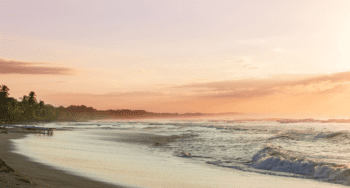Santa Teresa & Montezuma Costa Rica: What's Covered
Santa Teresa and Montezuma sit on the southern Nicoya Peninsula, about 20 minutes apart, offering authentic bohemian vibes without tourist crowds. Getting there requires the 1.5-hour Paquera ferry from Puntarenas ($3 foot passengers, $15-20 vehicles) plus 45-60 minutes of challenging road conditions that demand a 4×4 vehicle. Santa Teresa delivers world-class surf and modern amenities while Montezuma maintains its 1960s artistic charm with local sodas and authentic character. Having reliable transportation unlocks both towns plus hidden beaches along the coast.
Quick Facts:
- Ferry runs every 2-3 hours (last departure around 6:30 PM – verify current times)
- Dry season December-April ideal for access, green season May-November offers 30-40% lower rates and fewer crowds
- Best surf months: April-October for size, December-March for consistency
- Cell service spotty, nearest medical facilities in Paquera or Nicoya (1-2 hours)
- Book accommodations months ahead for Christmas, New Year, and Easter week
Top 3 Experiences:
- Santa Teresa Surf & Sunset Sessions – Consistent year-round waves at Playa Carmen for beginners, powerful breaks at southern end for experts. Daily sunset gatherings where locals and visitors connect.
- Montezuma Waterfalls – 20-minute walk from town center to natural pools and cascades perfect for swimming and cliff jumping. Start early (7-8 AM) to avoid crowds.
- Cabo Blanco Nature Reserve – Hiking trails through Costa Rica’s last remaining dry tropical forest leading to pristine beaches accessible only on foot.
Unlike Tamarindo’s crowds or Manuel Antonio’s tour buses, these towns reward travelers who embrace authentic local culture over resort-style convenience.
If you need any help with a Costa Rica car rental, contact us now!
Getting to Santa Teresa and Montezuma isn’t exactly a quick trip from the airport. You’ll cross a ferry, navigate some seriously bumpy roads, and probably question your GPS at least twice. But here’s the thing about those challenging roads – they’re exactly what keeps these beach towns authentic.
While Tamarindo gets the crowds and Manuel Antonio attracts the tour buses, Santa Teresa and Montezuma remain refreshingly uncommercialized. These neighboring coastal gems offer something increasingly rare in Costa Rica — genuine bohemian vibes without the tourist traps.
Whether you’re chasing world-class surf breaks or seeking that perfect yoga retreat setting, this corner of Guanacaste delivers experiences you simply can’t find anywhere else.

What Makes These Nicoya Peninsula Towns So Special?
Santa Teresa and Montezuma sit about 20 minutes apart on the southern tip of the Nicoya Peninsula, but they couldn’t feel more different. Think of Montezuma as the artistic older sibling — established in the 1960s by European backpackers and still maintaining that laid-back, alternative vibe.
Santa Teresa, meanwhile, is the surf-obsessed younger cousin who discovered Instagram and learned to balance bohemian charm with modern amenities.
How Different Are Santa Teresa and Montezuma Really?
The real magic happens in contrast. Montezuma centers around a small town with a proper plaza, local sodas serving authentic casados, and enough character to keep you wandering for hours.
Santa Teresa stretches along several kilometers of coastline, where surf shops and yoga studios blend seamlessly with high-end restaurants and boutique accommodations.
Local insight: Locals call the entire area “Mal País” (bad land), referencing the challenging access rather than the destination quality. Don’t let the name fool you — this “bad land” produces some of Costa Rica’s most memorable sunsets.
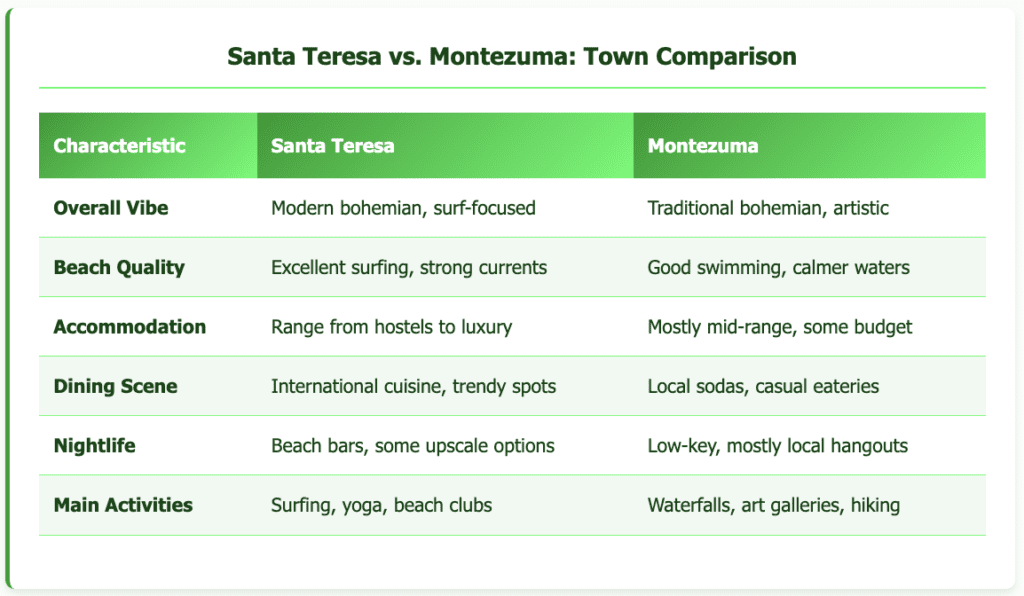
How Do You Actually Get There? The Ferry Adventure and Road Realities
Here’s where most travel guides get it wrong — they make the journey sound easier than it actually is. The truth? Getting to Santa Teresa and Montezuma requires patience, planning, and definitely a 4×4 vehicle if you’re driving.
What’s the Deal with the Paquera Ferry?
The most common route involves taking the Paquera ferry from Puntarenas. This isn’t just transportation — it’s part of the experience.
The 1.5-hour ferry ride across the Gulf of Nicoya offers spectacular views and a chance to decompress before you hit the road.
When Does the Ferry Actually Run?
Ferry Schedule Reality Check:
- Departures run roughly every 2-3 hours, but schedules change seasonally
- The last ferry typically leaves around 6:30 PM (verify current times)
- During Semana Santa (Easter Week) and Christmas, expect hour-long waits
- Foot passengers pay about $3; vehicles cost $15-20, depending on size
Pro tip: Download the ferry schedule to your phone before leaving cell service. The posted schedules at terminals aren’t always current, and missing the last ferry means an overnight stay in Puntarenas.
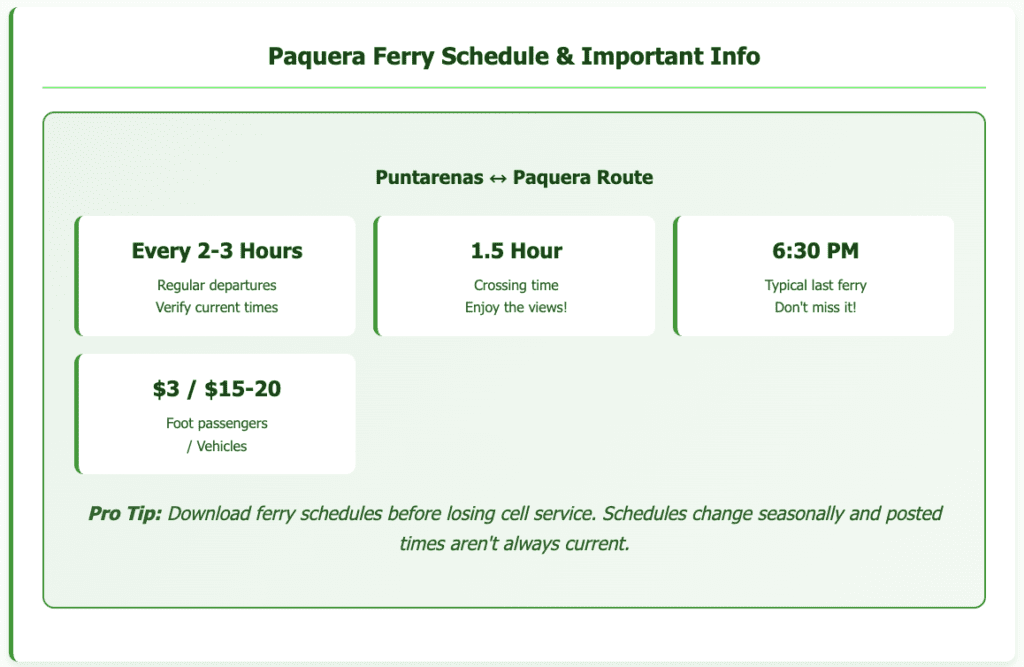
What’s the Drive Like After the Ferry?
After disembarking in Paquera, you’ve got 45-60 minutes of driving ahead. This isn’t highway driving — think steep hills, narrow bridges, and sections that turn into minor obstacle courses during green season.
Which Route Should You Take?
The road splits about 10 minutes before reaching the coast. Left takes you to Montezuma first, then continues to Santa Teresa. Right heads directly to Santa Teresa via Mal País.
Both routes have their challenges, but the direct Santa Teresa route involves more technical sections.

Why Is Santa Teresa Such a Big Deal for Surfers?
Santa Teresa has mastered the art of feeling remote while offering genuine convenience. The main beach stretches for kilometers, creating space for everyone from beginner surfers to seasoned pros seeking that perfect barrel.
What Makes the Waves Here So Consistent?
The waves here break consistently year-round, with offshore winds most mornings creating clean conditions perfect for all skill levels. Playa Carmen (the main beach) offers gentle waves ideal for beginners.
Meanwhile, Playa Santa Teresa’s southern end delivers powerful breaks that challenge experienced surfers.
When’s the Best Time to Surf?
Surf Season Breakdown:
- Dry season: Smaller, more consistent waves (3-5 feet average)
- Green season: Bigger swells with more power (4-8 feet average)
- Peak surf months: April-October for size, December-March for consistency
The surf culture here goes beyond just riding waves. You’ll find board shapers crafting custom boards, surf photographers capturing the action, and instructors who’ve been teaching on these beaches for decades.
This isn’t manufactured surf tourism — it’s an authentic community that welcomes newcomers.
What Else Can You Do in Santa Teresa Besides Surfing?
While surfing dominates the scene, Santa Teresa offers a surprising variety. The nearby Cabo Blanco Nature Reserve protects some of Costa Rica’s last remaining dry tropical forest, with hiking trails leading to pristine beaches accessible only on foot.
What Experiences Are Actually Worth Your Time?
Don’t miss experiences:
- Sunset sessions at Playa Carmen: The daily gathering where locals and visitors watch the sun disappear into the Pacific
- Horseback riding to Mal País: Traditional transportation that lets you cover more ground while experiencing the landscape
- Canopy tours at nearby reserves: Zipline through tropical forest with ocean views
- Yoga classes overlooking the ocean: Multiple studios offer daily sessions with world-class instructors
Where Should You Stay in Santa Teresa?
Accommodation ranges from backpacker hostels to luxury resorts, but book ahead during peak season (December-April). The best locations sit within walking distance of Playa Carmen while maintaining some separation from the main road’s dust and noise.
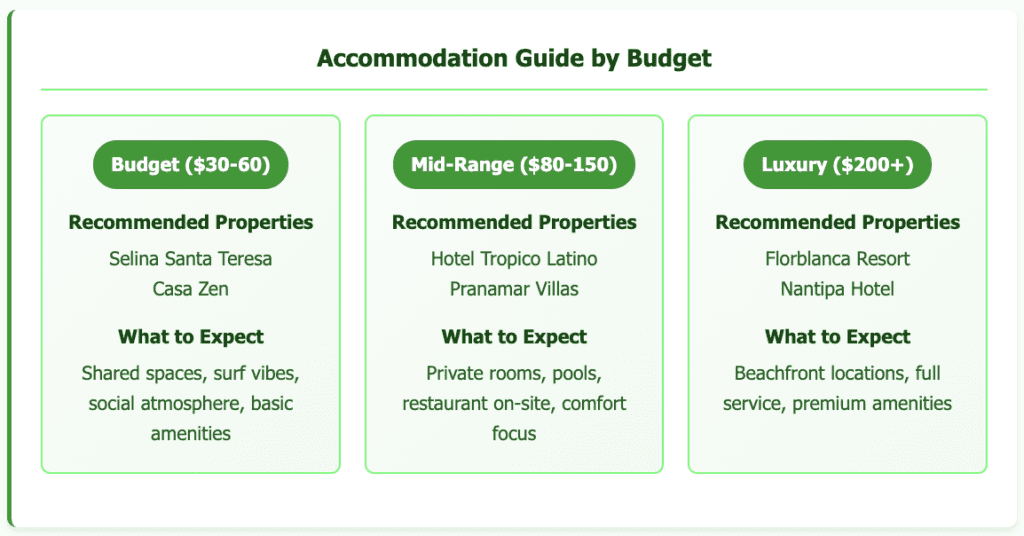
Why Does Montezuma Feel More Authentic?
Montezuma feels like stepping back in time to when travelers came seeking adventure rather than Instagram photos. The town centers around a small plaza where locals play soccer at sunset and vendors sell fresh fruit from bicycle carts.
Are the Montezuma Waterfalls Really Worth the Hike?
The famous Montezuma Waterfalls sit just 20 20-minute walk from the town center. This isn’t a manicured tourist attraction — it’s a series of natural pools and cascades where you can swim, cliff jump (if you’re brave), and cool off after hot beach days.
The hike follows a well-worn path through tropical forest, with several water crossings. During the dry season, the water runs clear and inviting. Green season brings higher water levels and more dramatic cascades, though swimming becomes trickier.
How Should You Approach the Waterfalls?
Waterfall visiting tips:
- Start early (7-8 AM) to avoid crowds and heat
- Bring reef-safe sunscreen — you’ll be in and out of the water
- Wear shoes with a good grip; rocks get slippery
- Respect local guidelines about cliff jumping heights
What’s the Story with Montezuma’s Art Scene?
What sets Montezuma apart is its authentic artistic community. European artists who arrived in the 1960s established galleries and workshops that continue today.
You’ll find everything from driftwood sculptures to traditional Costa Rican ceramics, often created by artists who’ve lived here for decades.
How Long Do You Need to Explore Montezuma?
The town’s compact size means you can explore everything on foot in a few hours, but plan to linger. Conversations happen easily here — whether you’re sharing a table at a local soda or browsing handmade jewelry at the weekend market.
Where Do You Eat in Montezuma vs Santa Teresa?
What’s the Food Scene Like in Montezuma?
Montezuma’s lodging reflects its authentic character — expect personality over polish. Most accommodations are locally owned, often by families who’ve been part of the community for generations.
The dining scene centers around fresh seafood and traditional Costa Rican dishes. While you won’t find the international fusion restaurants of Santa Teresa, you’ll discover family recipes and preparation methods that haven’t changed in decades.
Local dining recommendations:
- Soda Monte Sol: Family-run spot serving authentic casados since 1987
- Cocolores: Beachfront location with fresh fish caught daily by local fishermen
- Chico’s Bar: Evening gathering spot where locals and travelers mix naturally

How Do You Get Between Towns and Around the Area?
Once you’re in the area, getting between Santa Teresa and Montezuma is straightforward — about 20 minutes by car or organized shuttle. The road connecting them stays in better condition than the access routes, though it’s still unpaved in sections.
What Are Your Transportation Options?
Rental car advantages: Complete freedom to explore hidden beaches, visit during optimal times, and carry surf equipment or beach gear without hassle. The challenging access roads make a reliable 4×4 essential.
Shuttle services: Several companies run scheduled shuttles between major accommodations and between the two towns. These work well if you’re staying in one location and making day trips.
Bicycle rentals: Both towns offer bike rentals perfect for getting around locally. The flat coastal areas work well for cycling, though the heat during midday makes early morning or late afternoon rides most comfortable.
Why Does a 4×4 Make Such a Difference Here?
With locations at both major airports and the ability to deliver vehicles to your accommodation, Vamos eliminates the transportation stress that keeps many travelers from experiencing these authentic beach towns.
Local expertise includes current road condition updates and route recommendations based on your specific travel dates.
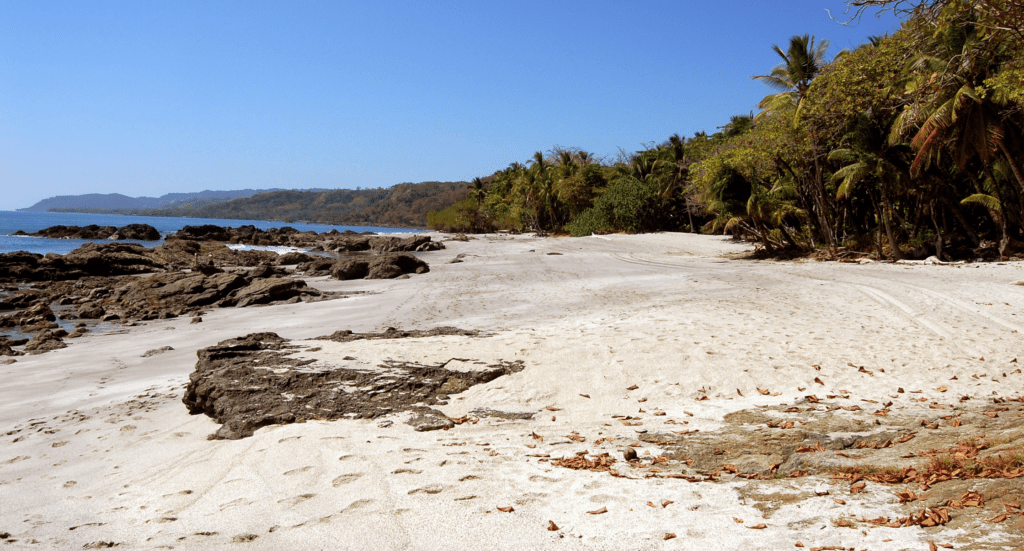
When Should You Actually Visit? Understanding the Seasons
The southern Nicoya Peninsula experiences distinct seasonal differences that affect everything from road conditions to accommodation availability.
What’s It Like During The Dry Season (December-April)?
This represents ideal conditions for accessing both towns. Roads stay passable with 2WD vehicles (though 4×4 remains recommended), ferry schedules run consistently, and beach activities happen under reliably sunny skies.
However, popularity brings challenges. Accommodation books months ahead, especially around Christmas/New Year and Easter week.
Ferry waits extend during peak periods, and the scenic dusty roads can feel less scenic when you’re following a convoy of vehicles.
Why Consider Green Season (May-November)?
The green season reveals these destinations at their most authentic. Crowds thin dramatically, accommodation rates drop 30-40%, and the landscape transforms into a lush tropical paradise.
The tradeoff involves accessibility challenges. Muddy sections require careful navigation, and ferry schedules occasionally adjust due to weather.
However, these minor inconveniences reward you with beaches often shared with just a handful of others.
What’s Each Month Really Like?
Monthly breakdown:
- May-June: Ideal transition period with fewer crowds but good weather
- July-August: “Little dry season” with excellent conditions and moderate crowds
- September-November: Heaviest rains but lowest prices and authentic local atmosphere
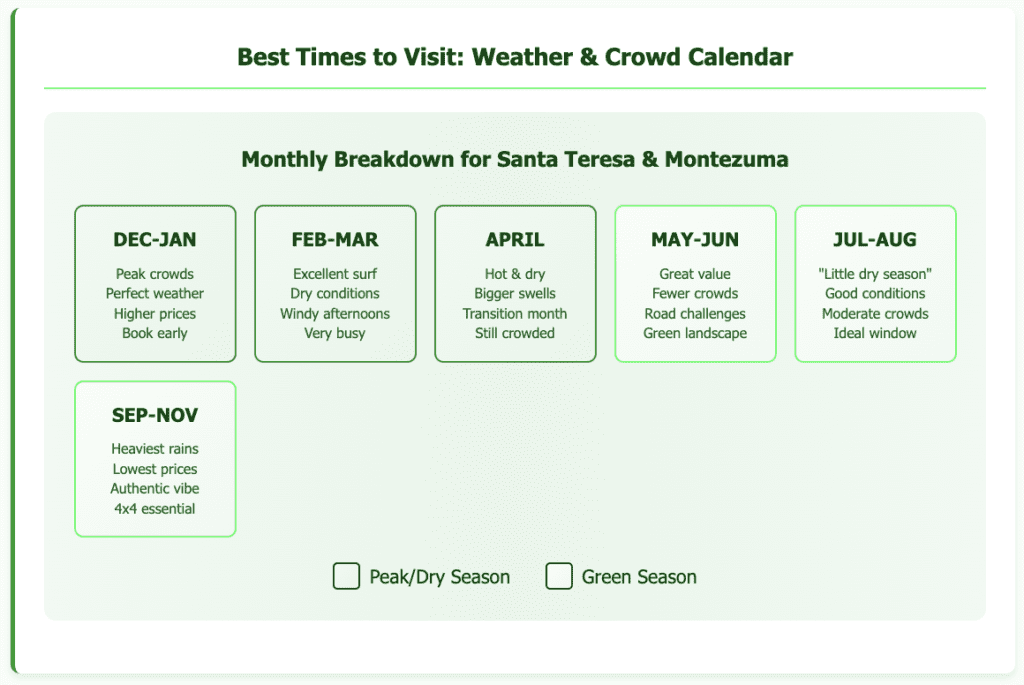
What Should You Actually Pack for Remote Beach Living?
These towns maintain their charm partly because they lack the convenience infrastructure of more developed destinations. Plan accordingly.
What Can’t You Forget?
Essential items:
- Reef-safe sunscreen (limited availability locally)
- Insect repellent for evening beach walks
- Quick-dry clothing for multiple activities
- Waterproof bags for ferry crossings and beach days
- Cash in small bills (ATMs exist, but can run empty)
Will You Have Internet and Phone Service?
Cell service exists but remains spotty, especially in accommodations away from town centers. Many visitors find this disconnection refreshing, but plan accordingly if you need reliable internet for work or travel coordination.
WiFi availability varies by accommodation. Budget properties may offer limited connectivity, while higher-end resorts typically provide reliable service in common areas.
What About Health and Safety Considerations?
Both towns maintain Costa Rica’s general safety standards, but remote locations require extra preparation.
What Should You Know About Medical Services?
- Water quality is generally good, but bottled water provides peace of mind
- Nearest medical facilities are in Paquera or Nicoya (1-2 hours, depending on ferry schedules)
- Strong ocean currents require respect — always swim near lifeguarded areas when possible
- Surfing conditions can change rapidly — seek local advice before entering unknown breaks

Ready to Experience Costa Rica’s Most Authentic Beach Towns?
The key to loving Santa Teresa and Montezuma lies in embracing their authentic character rather than expecting resort-style convenience. These destinations reward travelers who appreciate genuine local culture, world-class natural beauty, and the kind of laid-back atmosphere that’s becoming increasingly rare.
Plan for the transportation challenges, pack appropriately for remote beach living, and prepare to discover why surfers, artists, and free spirits have been drawn to this corner of Costa Rica for decades.
What’s Your Next Move?
Whether you choose Santa Teresa’s modern bohemian vibe or Montezuma’s traditional artistic atmosphere, you’ll leave understanding why locals call this area paradise — despite (or perhaps because of) those challenging roads that keep it special.
Ready to explore Costa Rica’s most authentic beach towns? Our 4×4 rental service includes detailed route guidance, current road condition updates, and 24/7 support to ensure your southern Nicoya Peninsula adventure starts smoothly.
Contact our local experts to plan your transportation and get insider tips that transform challenging access routes into part of the adventure.
¡Pura vida! and safe travels to these incredible destinations where the journey becomes part of the story you’ll tell for years to come.



